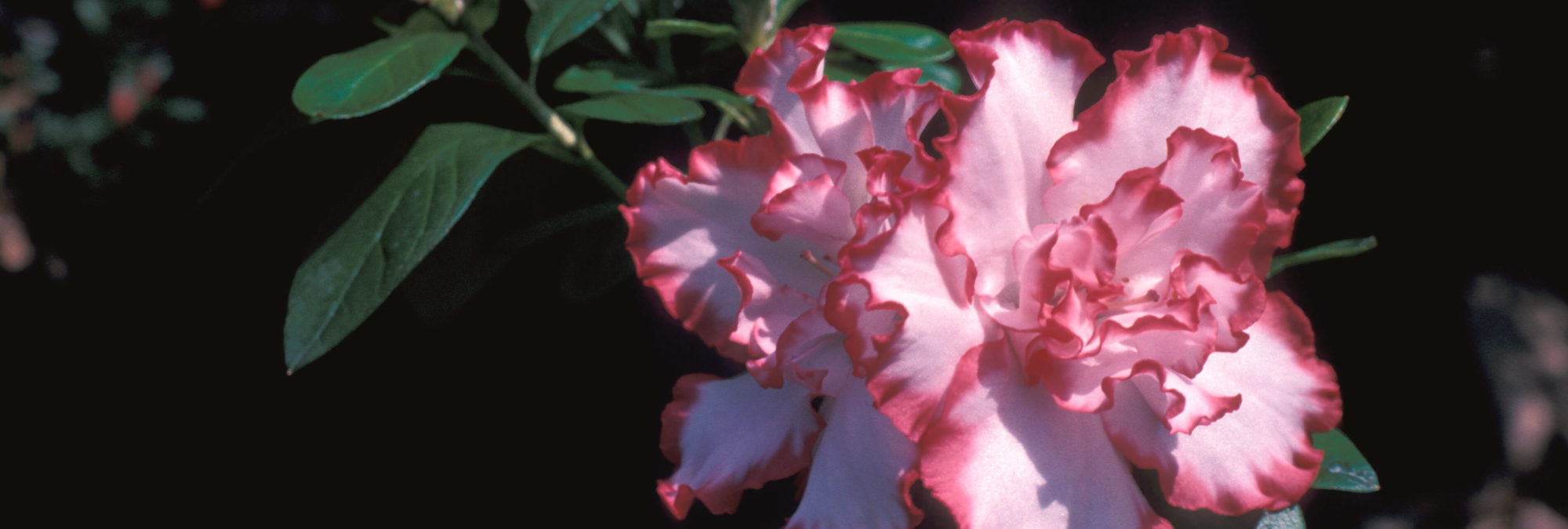satsuki azaleas | overview | links || related pages
Satsuki evergreen azaleas have been hybridized in Japan for at least 500 years. The first Satsuki were probably natural hybrids of R. indicum and R. tamurae. In general, they are late-blooming (mid-May and June), with 1 to 5 inch single flowers, although some have hose-in-hose, semi-double and fully double flowers. Satsuki flower shapes range from rounded overlapping lobes to narrow wide-spaced lobes, with lobe edges ranging from flat to frilled.
Flower colors vary from white to pink, yellowish pink, red, reddish orange and purple. Color patterns include solids, and stripes, flakes, lines, sectors and margins of color on a lighter background. The complete range of color patterns can appear on the same plant, differently each year. These color patterns are highly prized by the Japanese, and have been carefully described and classified starting as early as 1692 in the book A Brocade Pillow. The current color pattern nomenclature is shown on the azalea flowers page.
Satsuki foliage length varies from about 1/2 inch to 2 inches, with shapes ranging from lanceolate to obovate to ovate. A few have contorted twisted leaves, and another few have variegated leaves, either blotched or margined with yellow.
Most Satsuki are compact, twiggy, slow growing plants, ranging from low and spreading to about 5 or 6 feet high in 10 or 15 years. The plants are usually rounded in shape, although some are upright and some are pendulous.
Most Satsuki are cold-hardy to 0°F, with a few hardy to -10°F. They should be sited with protection from afternoon sun.
Names
Satsuki names have been transliterated from Kanji to English, with spelling and spacing variations depending on the transliteration system used. For example, ‘Kinsai’, ‘Kinzai’, ‘Kin-no-sai’ and ‘Kin-no-zai’ are all acceptable names for the same plant. Capitalization also varies from Japanese capitalization, such as ‘Azuma-no-Hana’, to the capitalization endorsed by the International Code of Nomenclature for Cultivated Plants, such as ‘Azuma-no-hana’.
Japanese Satsuki societies publish an updated Satsuki “Dictionary” about every 5 years. Each dictionary includes color pictures and descriptive Kanji text for about 1000 Satsuki azaleas, arranged in Japanese alphabetic order. Only the plant names are in English.
Indexes are available below in English alphabetic order, to save a lot of page flipping when you are looking for the picture of a particular azalea. To help when an index is not at hand, a partial listing of the Japanese alphabetic order is (courtesy of Bill Miller):
a i u e o ka k ku ke ko sa sh su se so ta chi tsu te to na ni nu ne no ha hi fu he ho ma mi mu me mo ya yu yo ra r ru re ro wa Read the table across and down. Thus, for example, ‘Izayoi’ follows ‘Ariake-no-tsuki’, and ‘Kaisen’ follows ‘Onyo’. Complications include letter substitutions such as “g” for “k” (so ‘Kagetsu-no-homare’, ‘Gakurei’ and ‘Kako’ are in alphabetic order), and “d” for “t” (so ‘Tatsumi-no-hikari’, ‘Datemurasaki’ and ‘Tanima-no-yuki’ are in alphabetic order).
Satsuki Dictionary Indexes
Click 1997 Satsuki Dictionary Index to download a 26 KB PDF file of an index to its plants [Errata: ‘Hikari-no-Masamune’ 892, ‘Komachiwarai’ 591]. Click here to instead see this index online.
Click 1983 Satsuki Dictionary Index to download a 22KB PDF file of an index to that “little fat Satsuki book”. Click here to instead see this index online.
hybrid groups (parent page)

